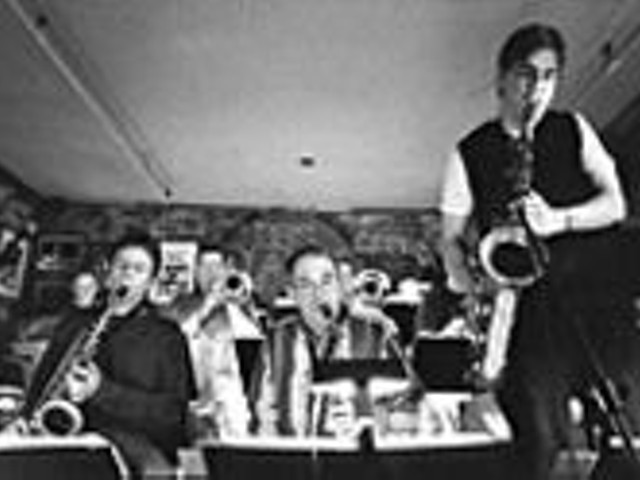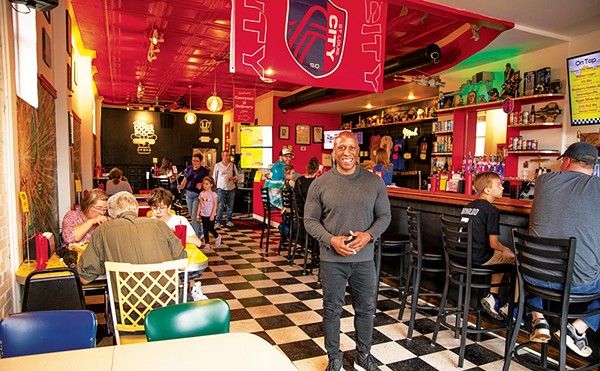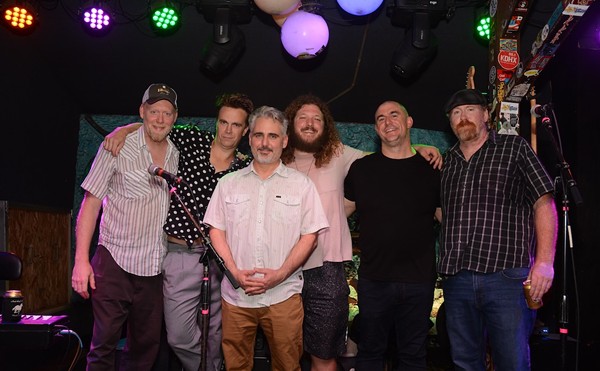Wherever it's coming from, you can hear the beat 24 hours a day in South Beach during the Winter Music Conference, an annual festival that celebrates dance music in all its myriad incarnations. It never stops for a breath, never wavers from the 4/4 pounding that seems to demand that your body obey its measure. If it's not coming from a silver Benz or a platinum Navigator, the beat's burping from pizza stands and designer salons; it's leaking out of third-floor apartments, billowing onto the beach. It's almost as though an amplified metronome is buried in the heart of South Beach, deep beneath the sand and the art deco, a mile below the gaggles of models; the lady in the "Got Blow?" half-T; the macho, macho men; the black-socked Germans: A mile below Miami, the beat bursts from every crevice as though escaping from a pressurized pit.
There's even a cable station, channel 116, that seems to gauge the beat. No shit. Turn on the station at 4 p.m. or 4 a.m., and you'll see a black-and-white wave, jumping like a seismograph, gauging something. It doesn't take a leap to imagine that the wave is measuring the infinite Miami beat, one that crosses cultures at the beginning of this new century, one that is the sound of today (even if you're not hearing the music on the radio yet). In Miami, as in every cosmopolitan area around the globe, the sound these days is in the pounding, in that big-ass beat. Gone is the guitar, at least for now; in its stead has arrived the four-on-the-floor, computer-generated stomp.
Something fascinating and, until now, unprecedented in popular music -- or any music, for that matter -- has begun to take place over the past decade: A global cross-pollination is occurring as sounds from across the world simultaneously merge and intermingle, as tendrils curl around each other and pull disparate musics together to create a world music. It's not the kind of world music Paul Simon and David Byrne play but a music that knows no ethnicities or borders. It is becoming apparent that, for the first time in human history, as a result of the globe's shrinkage in the wake of the computer/Internet/whatnot revolution, a universal sound is being formed. Not a variation on a region-specific theme -- as both European classical music and rock & roll manifested itself around the globe -- but a new kind of musical reality, one that jumps latitude lines effortlessly. And it has manifested itself in Miami during the WMC.
Each region of the world is known for a specific style of music: In Argentina, it's the tango. Great Britain has traditional folk. America has its blues and country & western, Japan its gagaku and koto musics, Africa 100 variations on that glorious rhythm. It's never been much of a stretch to distinguish one from another or to at least determine the general origin of a music on the basis of its tone. New electronic music -- house and techno especially -- destroys these borders. You can't tell the ethnicity of Ken Ishii by the music he creates, nor can you tell Basement Jaxx's nationality from their music. Is this a good thing or a bad thing? Neither. It is what it is: the sound of a changing world.
During the WMC, hundreds of DJs from all over the world were spinning: Germans, Brits, Americans, South Americans, Mexicans, Japanese -- even Canadians. They spun back to back, tag-teamed on four turntables together without the aid of translator. At a club called Red, three legends of Detroit techno -- Stacey Pullen, Derrick May and Kevin Saunderson -- spun with Japanese techno producer Ishii. At Winter Oasis 5, Brits spun alongside Hispanics, Pennsylvanians, Canadians, Japanese, Jamaicans and Scots. One would have been hard-pressed to determine the nationality of any music coming from the sound systems.
WMC isn't about the "conference." It's kind of beside the point. Panels seem useless (though we didn't attend any), and the conference hotel is 60 blocks north of where the real action is, in the heart of South Beach. Unlike South by Southwest in Austin, Texas, where the conference books all the acts and schedules them in the clubs, the Winter Music Conference itself is a magnet that draws dance-music fans to Miami for a nonstop five-day party. Clubs book their own music without any sort of approval from WMC; the only concrete reason to sign up for the festival is to get a badge, which gains you entry to many of the clubs for free (though the renegade parties charge more if you present your badge at the door, a defiant "Fuck you" to the industry). It's a free-for-all. It's chaos. It's woefully unorganized. It's a gas-gas-gas.
There were a number of highlights in the four nights of music. Saturday night's Philadelphia showcase at Z (no relation to Dr. Zhivegas' club) was a stellar sampling of deep, dubby house, highlighted by Solomonic Sound's Rob Paine and Zach Eberz and Worship Records' Hakan Lidbo. (That Girl's Alexis Tucci was spotted at the club, checking out Chicago's Lady D.) Z is a beautiful space with a gothic Edward Gorey feel to it, all fancy curlicues and deep maroons; the management of some of St. Louis's cookie-cutter clubs would do well to trek to Miami to check out how a club should look).
Astralwerks, the huge stateside electronic record label (their roster includes the Chemical Brothers, Fatboy Slim, Basement Jaxx and others), held their annual beachfront throwdown, featuring Photek (a.k.a. Rupert Parkes), Norman Cook (a.k.a. Fatboy Slim) and Basement Jaxx. (The Superstars of Love, the only St. Louis act to perform at the WMC, were spotted at the Astralwerks party and gave us a predictably insane ride up the beach later in the evening). The next night, at Bed -- a hot new club recently featured in the New York Times that has as seating fancy beds all over the room and beautiful people lying on them -- Terry Lee Brown Jr. and Timewriter spun downtempo house.
The supreme highlight, by far, was Tuesday night's transcendent lineup at Red, featuring Pullen, May, Saunderson and Ishii. Pullen warmed up the crowd, and when May and Saunderson -- two of the mythic "Belleville Three" who forged the sound of techno in a Detroit suburb in the mid-'80s -- leaped onto four turntables and jumped back and forth for two hours, the pair created magic. You could see it on the faces of the dancers -- the sort of bliss that is the entire reason for the party. At one point, around 3:30 a.m., when the duo was peaking the set with hard, glorious techno, the crowd -- about 100 on the dance floor -- erupted as they danced. They screamed and hooted, even as they continued to move; they looked up beyond the sky to that secret place they had been craving since their arrival: nirvana. There was a nearly physical buzz in the crowd, and by 4 a.m., when Ishii unzipped the music and exploded with a huge, percussive orgasm, the crowd was in heaven.
At the WMC, the crowd is waiting for 4 a.m. That's when something in the air changes. It's when the night is vanishing but the morning has yet to arrive. It's when the lightweights have long since retired and the survivors -- and, sure, the druggies -- have been dancing for a few hours. Everyone's warmed up, so everyone's revved up. There's a palpable energy in the room, and it's an otherworldly feeling. No wonder the music is exploding simultaneously all over the world: the emotion that arrives at that moment doesn't speak a language, has no politics and suffers no existential crisis. It is what it is: the sound of release. The sound of celebration. The sound of music.





